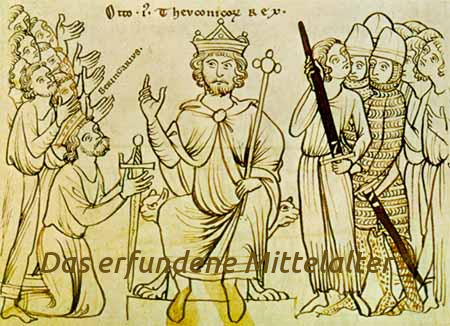| Espaņol | Italiano | Deutsch |
29.11.2022

German author Heribert Illig speculates that nearly 3 centuries have been invented throughout history.
After the year 614 one should jump to the year 911 and everything in between is pure invention. So today one should be in about 1725 and not 2022.
When I first heard it, I almost died laughing. So I started to investigate.
But I wonder: how and who could falsify the whole of European history?
The answer is very simple: if there was a forgery, it can only have been done by a central agency that had administration and command over all of Europe at that time. For the years mentioned i.e. 614-911 there is indeed a central authority and it is called the Vatican.
Only if the Vatican had agreed to and allowed it could this have taken place. But then there would also have been corruptions by emperors and kings. The Vatican does nothing for free.
Concruent examples
The Gospels of Jude and Philip
Regarding this context, I remembered an event. The Gospel of Jude was subjected to a test of the C14 at the University of Arizona. This test showed that the Gospel of Judas is approximately 1700 to 1800 years old and not 1800 to 1900 years old as is claimed on the web. Since the Gospel of Judas was signed by Judas himself, this would support the contrived Middle Ages thesis.
The Gospel of Philip would also be just over 1700 years old.
I will stop laughing about Mr. Illig for now.
Not to mention that the Gospel of Jude and the Gospel of Philip are not owned by the Vatican and are therefore reliable regarding age and the C14 test.
Further evidence
In my humble opinion, evidence on this hypothesis can only be found outside the Vatican, because the Vatican certainly has no interest in making public any of its own faults.
The Coptic calendar and its origin
According to the Coptic calendar, today (in 2022) we are in 1738.
The Copts separated from the Vatican in 451. Until then, they had the same time directions as the Catholics, in addition to the Julian calendar.
But now it is argued that they departed from Jesus in dates and instead began their calendar in the year of the glorious rise of the Roman emperor Diocletian.
Diocletian was the worst persecutor of Christians and mass murderer of Copts. This claim, in itself utterly ridiculous and not credible, has a basis in the official history books. In fact, this ridiculous claim is a slap in the face to all Copts.
It seems much more logical to me that the Copts continued the old Julian calendar, certainly leaving Christ as the basis. Certainly not their worst enemy and persecutor when this one took the throne.
But if I am right, then there should be something strange in the Coptic historiography of these three centuries.
Agathon, 13th Patriarch of the Copts
I take for example the 13th patriarch of the Copts "Agathon." He is said to have been patriarch from 654 to 673, that is, during the period of the "invented Middle Ages".
On the well-known South American website http://www.scielo.org.co the following information can be found:
Agathon was contemporary to the great bishop Zacharias of Sakha (Müller, 1991, pp. 2368a- 2369a; Evelyn-White, 1932, pp. 276-280) and Agathon like him was disciple of the Abraham and George (Coquin, 1991, pp. 12a-13a) the disciples of John the Hegumen of Scetis (Zanetti, 1996, pp. 273-405) "the last great saints" (Evelyn-White, 1932. pp. 278-280).
Sakha in the book of the History of the patriarchs.
During the patriarchate of Agathon the patriarch (661-677) (who is also contemporary to Agathon the Stylite) an incident showing the state of confusion between Chalcedonians and anti-Chalcedonians occurred in the city of Sakha, which was predominantly under the influence of a Chalcedonian majority. It had a magistrate, an archon by the name of Isaac, who, in conjunction with its Muslim governor, was able to prevail over the Chalcedonian majority. The viceroy of Egypt at the time was Maslamah ibn Makhlad ibn Samit al-Ansari (667-689). He sent seven bishops to Sakha to make an inquiry into the accusation that some officials had been branded. Together with Isaac, who was obviously a follower of Agathon the patriarch, the situation was clarified, and the accused were absolved. The life of Agathon the Stylite does not make any allusion to this event, which took place in his city.
In the end, the following conclusion is drawn:
Conclusion
Despite the abundant data that we possess about the city of Sakha, nothing is mentioned about Agathon the Stylite which means that from the seventh to the twelfth centuries, there was no veneration for Agathon.
In other words, Agathon the Stylite emerges only in the historical record of the 12th century. As all saints are allowed to do, he simply appears where it suits him. Even his date of birth is unknown, and the city of Sakha itself knows nothing about him.
Wikipedia (christian calendar, 15.10.2022): Around the year 1060, this annual calculation was put into use by the Roman Catholic Church.
This explains a lot, because shortly after 1060 we move to the 12th century and the cult of Agathon the Stylite also appears.
Besides
In 1060, the Catholic Church certainly "adapted" the annual calendar according to its own ideas and needs. Even a church over 1,000 years old was certainly desired at that time.
I have now definitely stopped laughing about the "invented Middle Ages" and formally apologize to the author of the book Heribert Illig for laughing at him.
Sources:
Scielo www.scielo.org (28.09.2022): Coptic liturgical texts relating to Agathon the Stylite
The University of Arizona (28.09.2022): Radiocarbon test to verify coptic gospel Judas
Wikipedia (28.09.2022): Erfundenes Mittelalter
Wikipedia (15.10.2022): Calendario copto
Wikipedia (15.10.2022): Imperatore Diocleziano
Wikipedia (28.09.2022): Christliche Zeitrechnung